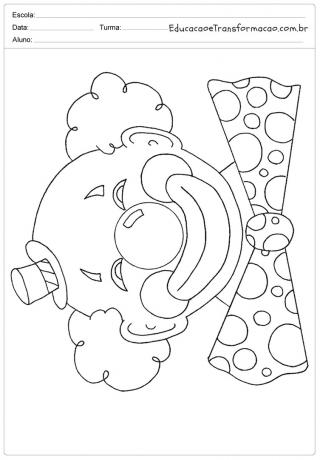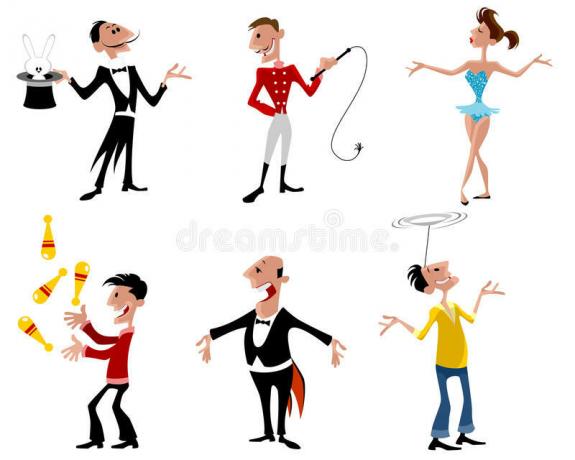Check this post for some tips and suggestions for your Circus Education Children's Day Class Plan.
O Circus day is celebrated annually in March, 27 th. This date serves to honor this type of entertainment that delights children and adults of all ages.
In the world of circuses, traditional clowns stand out, entertaining the public with comical and lively situations. However, performances by jugglers and wild or exotic animals are also typical of the circus.
However, currently circuses seek to focus on overcoming the human being, based on physical challenges. Animals used to be very mistreated, that's why they stopped becoming such a usual attraction of the main circuses.
See more:
Index


See also: 38 Activities for Circus Day

Also check: Circus Day Activities and Tips


Circus Day Lesson Plan Early Childhood Education – The Circus Artists
After the conversation, watch a video about the work of the circus professionals. Video Suggestion: The Circus Artist's Life
During group discussions, observe if the children report the names of professionals who work in the circus, contribute added information to the interview script. In circus play, take into account the children's involvement in the performance, registering whether they participate spontaneously or need encouragement from peers and teachers.
Others in: THE CIRCUS HAS ARRIVED - CHILDREN'S POETRY

Circus Day Lesson Plan Children's Education
Expand knowledge, giving a new meaning to the elements of the circus and develop reading and writing skills. (children aged 4 years).
Activity 1– Play a word game based on the circus world.
1st moment – Relate the circus to the elements that integrate it, such as: the artists, the physical space (canvas, stands, arena). In the activity, the teacher can play a game with words and guide how to complete the sentences.
Circus members:
In the circus there is!…………….
(a child completes the sentence with a word representing a member. Several rounds are made and words cannot be repeated). The teacher records each word on cardboard.
Circus members' actions:
The clown does…………………………………; the tightrope walker ……………………; the trapeze artist…………………………….; the magic…………
Products sold at the circus:
At the circus we buy ……………………………………………………….
Activity 2 – Elaborate a comic book.
1st moment – The teacher invites the children to build a comic book with the clown as the main character and follows a few steps:
combines and writes the initial idea (what will the story deal with?);
explains that the story will be drawn;
choose the characters to dialogue with the clown;
create a name for the clown;
helps describe characters (physical and visual characteristics);
prepares the script: frame by frame (where will each character stay? what will each character say?)
each child draws a character;
delivers the comics and the children draw the balloons;
the (a) teacher (a) cuts the drawings and the children paste them in the comics;
the children dictate what the characters say and the teacher writes on the balloons.
Note onomatopoeias and lines of movement are not included, given the age of the children.
Activity 3 – read strips.
1st moment – Based on the previous moment, the teacher teaches the children to read images from the comic strip, are informed that this is a conversation about Garfield and John going to the circus and a situation with the clown. For reading, students follow the steps below:
The children's language development level is evaluated, it is observed if they can:

Circus Day Lesson Plan Children's Education
Kindergarten students (4 years old) will be able to form the attitudes of the audience; identify the circus performers by the characters represented; and build an artistic language based on the circus language.
1st moment – The visit must be only for fun, being a way to motivate children in the circus world.
2nd moment – Children should observe the physical space of the circus, the elements that compose it, such as: ticket office, bleachers, chairs, arena, canvas (materials, shape, color, spatial arrangement) costumes, music and other accompanying elements, such as popcorn and cotton cart candy.
3rd Moment – Interview the circus artists. Organize, in advance with the children, some questions to interview the artists. In this item, to enable the children's resourcefulness, let them build and elaborate, with the help of the teacher, some questions, for example:
Assess whether the children observed, experienced and participated in the visit, questioning and pointing out the elements of the circus.

Class Plan Day of Circus Infant Education – Maternal
Take students to:
The activities will be developed in groups and individually with the interaction of the teacher in the classroom.
1st moment: conversation circle and afternoon prayer (Our Father).
2nd moment: children's songs;
3rd moment: programmed activities (plays, painting, collage, among others according to the lesson plan).
4th moment: snack
5th moment: free play with teacher-student interaction (houses, building games, among others)
6th moment: waiting for parents
1st moment: prayer, children's songs and children's stories attached.
2nd moment: painting with crayon on sulfite.
3rd moment: snack
4th moment: free games (bowling, carts, dolls, etc.)
5th moment: pedagogical games to set up and wait for the parents.
1st moment: prayer, children's songs.
2nd moment: children's tale about the Circus attached..
3rd moment: snack
4th moment: play with the children on the patio (balance on a line on the floor).
5th moment: puzzle and waiting for parents.
3rd DAY (Wednesday)
1st moment: prayer, children's songs and children's stories;
2nd moment: collage of crepe balls in the engraving of circus animals.
3rd moment: snack
4th moment: singing games.
5th moment: children's stories and waiting for parents.
4th DAY (Thursday)
1st moment: prayer, children's songs and children's stories;
2nd moment: physical education (activity time)
3rd moment: snack
4th moment: Children's DVD CD Xuxa 5 “Circus”.
5th moment: riding games and waiting for the parents.
1st moment: prayer, children's songs and children's stories;
2nd moment: clown engraving collage
3rd moment: snack
4th moment: play on the patio “setting the clown's mouth”.
5th moment: activity time
Circus Day Lesson Plan Children's Education – The Clown Has Arrived
Is there a show today? Yes sir! Do you have marmalade today? Yes sir! And there are also clowns, jugglers, tightrope walkers, tamers, illusionists, trapeze artists, globists. From this point on, start talking about the circus, ask the children who have been to the circus to tell: What did you like most?
After a good conversation we will register the information.
And still on the circle, count how many children in the room went to the circus and how many who haven't yet. WERE NOT WERE
Another activity would be for the teacher to show images of professionals who work in the circus, to be recognized by the children, then set up a mural with the image and name of the character. This activity is cool because it gives students who haven't been to the circus the opportunity to get to know through images some elements that make up a show.
*Then, propose the re-reading of Romero Brito's work “CLOWN”. Take advantage of this moment to work with colors and geometric shapes.
Watch the movie “Os Saltimbancos” Trapalhões. Humble employees, friends Didi (Renato Aragão), Dedé (Dedé Santana), Mussum (Mussum) and Zacarias (Zacarias) become the big attraction of the Bartolo circus, thanks to his incredible ability to make the audience to laugh. But their success comes at a price: the opposition of the magician Assis Satã and the greed of the Baron, the owner of the circus. Together, the four friends will have to fight them.
More in: Circus Day Activities – Early Childhood Education

Circus Day Lesson Plan Children's Education
Based on playful and imaginative play, encouraging creativity by promoting meaningful learning experiences. Through playing, the child will be developing areas of knowledge, in addition to stimulating curiosity, self-confidence and autonomy, as the instruments to be used as support will help, whether in the physical, social, intellectual or emotional aspect, thus providing its development integral. Identify the different types of shows and the changes caused during their creation to the present day.
Cross themes: ethics, solidarity, cooperation, respect for others.
We will start the circus day project with a little history of the circus. The film Madagascar 4 will be shown to the children, where they will be able to experience the animals that used to live in the circus and then the reasons why they can no longer be part of the circus art. We will identify some videos of the most famous circuses.
The project must be applied three times a week, one for each procedure, the literature must be a constant habit in the child's life, being performed all day and alternating with individual reading and collective.
It is necessary to rescue the oldest of all parts to reflect on the relationship: Animals x Circus.
Conducting a circus at the school providing students' presentations;
Subscribe to our email list and receive interesting information and updates in your email inbox
Thanks for signing up.